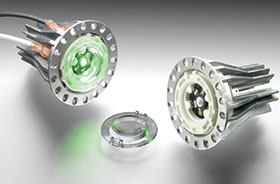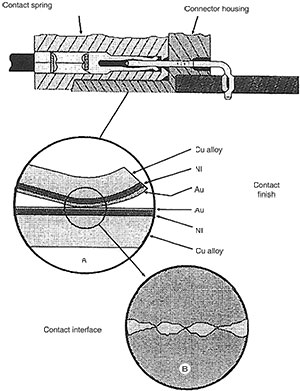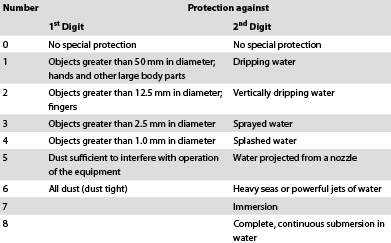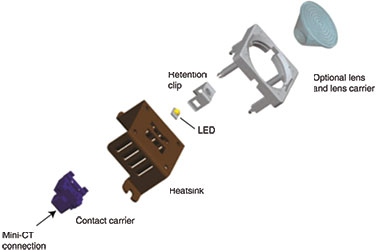

While pronouncements of the death of incandescent lights are premature, their future is dimming as new technologies offer high efficiencies and lower energy consumption. Solid-state lighting technology, in particular, is quickly entering the lighting mainstream.
While pronouncements of the death of incandescent lights are premature, their future is dimming as new technologies offer high efficiencies and lower energy consumption. Solid-state lighting technology, in particular, is quickly entering the lighting mainstream.
Arguably the most prominent and nearest-term solid-state lighting source suitable for general lighting is the ubiquitous LED, albeit a high-power version. Already the favoured technology in such applications as signage, jumbo displays and emergency lighting, these high-intensity LEDs are also finding use in interior accent and architectural lighting. At some time not too far off, LEDs will replace household incandescent lighting as the technology matures, costs decline, and energy-efficiency mandates are implemented.
Making new lighting technologies more affordable and thereby enabling new applications falls into two main categories:
Semiconductor processing: This category includes issues of both materials and fabrication. While outside the scope of this article, it must be mentioned as a key driver of commercial viability of solid-state lighting technology. As manufacturers solve fundamental materials problems, improve yields, and move to volume production, costs will decline.
Packaging: Packaging the light source for its final application is the area that is directly affected by the lighting designer, and can significantly affect long-term reliability, cost and usability. Where an incandescent light and its fixture are relatively simple embodiments of the well-known Edison socket, LEDs present a whole set of different and more challenging issues.
Since these LEDs are essentially point sources of light, new thermal, optical and packaging/integration considerations come into play. High power densities make thermal management a critical part of the fixture design process. Some level of electronics drive circuitry is required to provide the required constant-current source. With few exceptions, LEDs cannot be plugged directly into a normal AC line voltage source.
Connectors and solid-state lighting
Our concern here is with connector technology and the ways it can help (or hinder) making lighting more affordable and easier to apply and use. Connectors remain a critical part, but have too often been left to the end of the development cycle. This lack of foresight can result in fewer choices and higher costs (including cost of materials, cost of assembly, and cost of upkeep).
Integrating connector selection into early design phases opens options, gives more choice, and often lowers costs.
Not only is it important to consider connectors early in the design to gain the widest array of options, it’s equally important to understand some of the basics of connector technology to allow informed decisions about various options and trade-offs.
For example, TE Connectivity offers low-profile, surface-mount, two-position connectors designed for use in PCB-based LED strings, lighting controls, and other applications that can benefit from an easy poke-in wire termination to the PCB. The connector speeds assembly and routine maintenance of lighting systems through an application-specific design.
Connector basics
For our purposes, the basic connector consists of a housing and contacts used to create a separable electromechanical interface. The interface can be used for wire-to-wire, board-to-board, and wire-to-device/board connections. From a practical perspective, a connector is a system in which all the elements combine to make the connector work in its intended application. As shown in Figure 1, these physical elements can be segregated into:
• Housing design and material.
• Contact design and material.
• Contact plating system.

A detailed discussion of these elements is beyond the scope of this article, but the following are the most important factors to consider in lighting designs.
Environmental concerns
The environmental protection provided by the housing can encompass preventing contaminants (both solid and liquid) from getting into the connector interface and also preventing inadvertent physical contact with the electrical contacts. To prevent interface contamination, various sealing techniques are used. In sealed connectors the housing, in conjunction with various sealing devices, serves to prevent contaminants from entering into the contact area.
Electrical connector housing sealing levels typically adhere to the well-recognised IP levels (Figure 2). EN 60529 outlines an international classification system for the sealing effectiveness against both objects (tools, dust, fingers) and moisture. This classification system uses the letters IP (for ingress protection) followed by two digits. The first digit refers to protection from physical objects; the second digit deals with moisture. Most unsealed connector systems, therefore, have an inherent IP20 rating.

Preventing physical contact with the electrical contacts is also a key function performed by the housing, and is particularly important in higher-voltage applications. At a minimum, having some housing protection prevents or at least minimises potential handling damage to the contacts themselves that may occur during assembly or installation of the end product.
When dealing with elevated voltages (usually above 48 V), most safety standards require design features to prevent accidental physical contact with the electrical contact. In this case, contacts are recessed to some extent and often shrouded as a mechanical barrier to contact. Most standards around the globe use a ‘standard’ probe to confirm the housing design is adequate to prevent access.
Lastly, the housing must be robust enough to handle the end application’s environmental conditions. It is important to understand and establish what these are early in the selection process. If outdoor use is anticipated, then it is natural to specify a housing with a UV exposure rating.
If a connector is expected to be used in an abusive environment where it is subject to mechanical shock and impacts (such as what would be used in a concert or stage setting), then perhaps a heavily impact-modified polymer housing would be used, or perhaps even a connector with a protective metal shell.
High- or low-temperature applications require particular housing materials and determine whether thermoset or thermoplastic materials need to be used. If active latching is required, the designer must specify a polymer material that allows latch flexibility while still meeting other mechanical and electrical requirements.
Even chemical exposure needs to be considered; for example, if the connector is to be used in gasoline pump applications, you need to make sure the housing material can withstand continued exposure to volatile hydrocarbons without becoming brittle or fracturing.
Connector ratings
In selecting the best connector for an application, basic electrical, mechanical and environmental performance requirements must be identified and considered to optimise the selection.
Electrically, the connector must be compatible with the current levels and voltages of the application. Certainly, the basic continuous voltage and current needs to be considered but, in addition, transient and surge conditions that may occur over the life of the product need to be identified.
Mechanical considerations can cover a broad range of features. As with all electronics, the trend is toward miniaturisation, so connectors require tighter contact pitches to pack more contacts in a smaller area. As a result, the physical size of the connector relative to the application needs to be considered in selecting the connector.
Mating direction and wire dress similarly need to be considered relative to their intended application in the system. How the connectors are held together after mating can also impact the selection process since some connectors rely on active mechanical latches, others utilise small detent bumps, and some have nothing other than friction to hold them together.
Beyond obvious form factor issues, the connector must also be evaluated for the degree to which it can withstand mechanical abuse, such as vibration, shock and the like.
Environmentally, the connector must withstand both application temperature ranges and processing temperatures (such as those experienced during reflow soldering of surface-mount connectors). The application environment will define additional needs, such as sealing, the ability to withstand solvents or salt spray, high altitudes, or other extremes. In outdoor applications, UV exposure capability is critical to reliable, long-term connector performance.
While typically not seen in lighting applications, shielding in a noisy electromagnetic environment may also be necessary. In some instances, both shielded and unshielded versions of the same connector are offered by connector suppliers.
The connector must be designed specifically to terminate the cable’s shield since it is practically impossible to convert a non-shielded connector design to a shielded one. The key to a reliable, effective shield is to provide a 360° termination that maintains a low-impedance path from the cable through the connector to ground.
Thermal considerations
Signal applications typically do not require thermal management. Power applications do.
Power contacts have a current rating that indicates the maximum current that the contact can carry continuously. This rating is usually based on a 30°C temperature rise on the contact and is based on measurements of a single contact. When multiple power contacts are used in a housing, the allowable current is derated to allow suitable heat dissipation. It is important therefore for the end user to consult the connector’s product specification to determine the suitable current derating factor when evaluating a connector system.
In high-intensity LED applications, the LEDs themselves generate enough heat to require careful consideration to thermal management – typically this is accomplished by a heatsink and sometimes forced air cooling. The challenge of integrating thermal management into a system is an excellent example of why it is important to consider interconnections early in the design process. This often poses unique system packaging challenges since most of the new high-intensity LEDs are small and are often packaged as surface-mount devices (SMD).
Integrating the connector system in amongst the LEDs, circuit boards, optics and thermal devices is often quite challenging if left to the end of the design process. Evaluation of the interconnect earlier on in the design process provides for a more tightly integrated, optimised solution that can make assembly and, if needed, repair much more efficient.
Beyond the normal electromechanical aspects, new interconnections must also address the special needs of solid-state lighting. These include higher operating temperatures and the ability to provide housings in specific colours so the connector blends into the visible parts of the lighting designer’s fixture.
Furthermore, for lighting applications it is often very desirable to use circuit board-mounted connectors with softened edges to minimise shadowing and the possibility of partially occluding the light output of the low-profile surface-mount LEDs.
The next step in connectors
So now that we’ve defined the key elements of a connector, let’s expand the definition a bit.
From an application standpoint, it is well known that LEDs perform better when operating at lower temperatures. As mentioned earlier, current LED lighting design methodology usually incorporates one or more LEDs onto a circuit board, usually metal clad for thermal reasons.
This assembly is then integrated into the fixture by a lighting fixture designer. Throwing out conventional logic that mandates a circuit board in the system, one could combine a heatsink into the electromechanical design of the connector to create a thermoelectric connector that mates directly to the LED.
An example is the high-intensity LED holder (shown in Figure 3) that TE Connectivity designed for use with a high-intensity LED. The holder combines a small footprint and low profile with a snap-together contact system for both direct electrical and thermal connections directly to the LED. Without the need for solder, thermal adhesives, or metal-clad printed circuit boards, application is simple, cost-effective and expands mounting options beyond the planar constraints of circuit boards.

As an added benefit, replacement of a faulty LED or changing colours is equally straightforward since all it entails is removing the retention clip, removing the LED, and replacing it with a new one. The basic holder kit includes a contact carrier and an LED retention clip used to secure the LED to the carrier. The module-to-cable interface is a standard two-position TE Connectivity Mini CT post and receptacle connection that facilitates plug-and-play operation.
A note on standards and approvals
Naturally, any connector must meet agency requirements for any region of the world in which it is used. Regulatory agencies like UL and CSA in North America and IEC, TUV, and VDE in Europe have requirements to provide for safe application of a product.
Selecting components that have already gone through the approval process speeds design and simplifies approval of the final product. Given the global nature of the lighting market, the designer must confirm that components meet all regional or local requirements. Being cognisant of the connector agency requirements, as well as those needed by the end application, is critical to the successful selection and integration of the appropriate connector system.
Conclusion
Selecting the best connector for a lighting application is a matter of matching application requirements to available connectors, with proper consideration given to performance and costs. It can’t be stressed enough the wisdom of giving connector selection the same thought and consideration as you give thermal, optical and electrical issues at the early design stage. Indeed, the right connector can address these issues.
We haven’t mentioned cost. The acquisition cost of the connector is one thing; the applied cost is quite another. Newer generations of application-specific connectors for lighting can reduce engineering costs, manufacturing costs, warranty costs and maintenance costs. But one key to realising these savings is to understand connector basics and to integrate connector selection into the overall design process.
These new solid-state lighting systems with their inherent longevity demand equally robust connector systems while the LEDs, thermal solution, optics and packaging comprise a considerable part of the overall cost of the lighting system. The connector is usually a small part of the overall cost and is often specified without adequate consideration and balancing of cost versus performance.
It makes little sense to scrimp on the one component that your entire fixture relies on for power. Without a reliable and appropriate connector system, the lighting fixture, however well designed and aesthetically pleasing it is, becomes a dull, static (and unlit) non-functional objet d’art.
Spend some time and consideration selecting the appropriate, proven connector system for the application, even if it costs a little more. It will pay dividends in the long run.
For more information contact Quatraine Domoney, Avnet South Africa, +27 11 319 8600, [email protected], www.avnet.co.za

© Technews Publishing (Pty) Ltd | All Rights Reserved